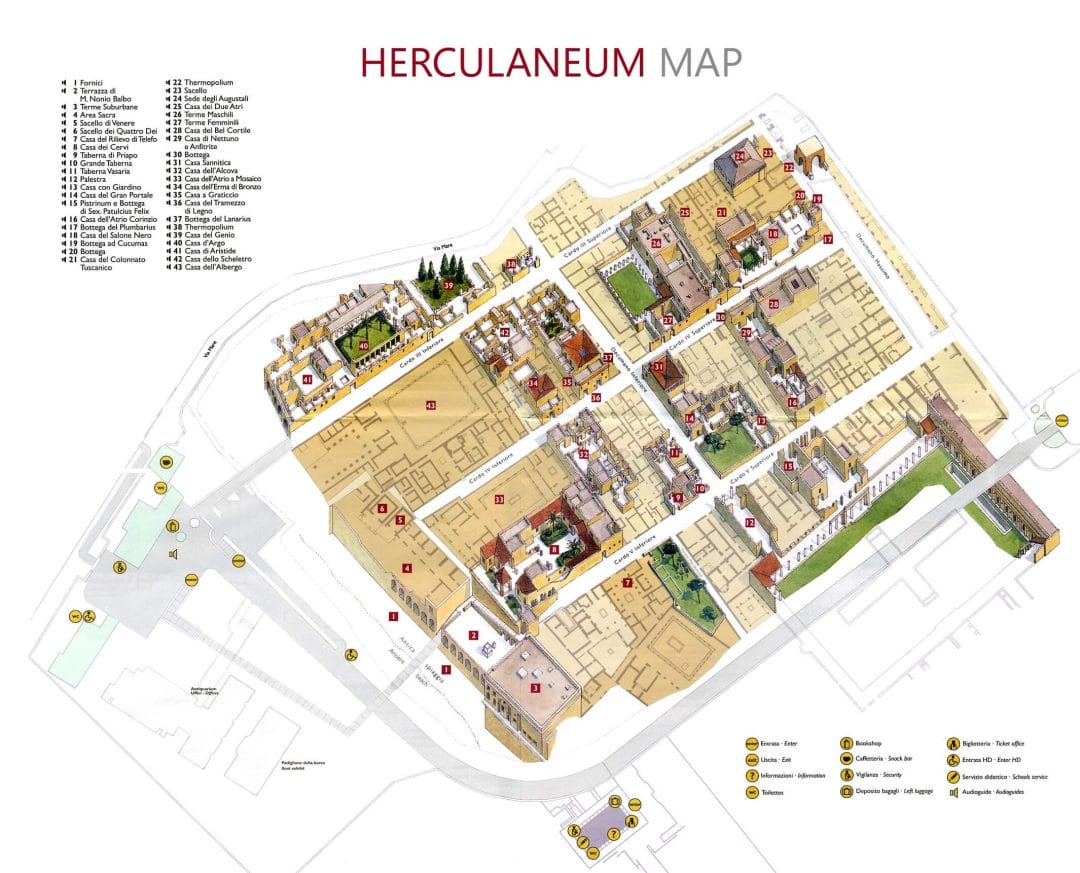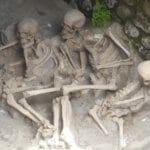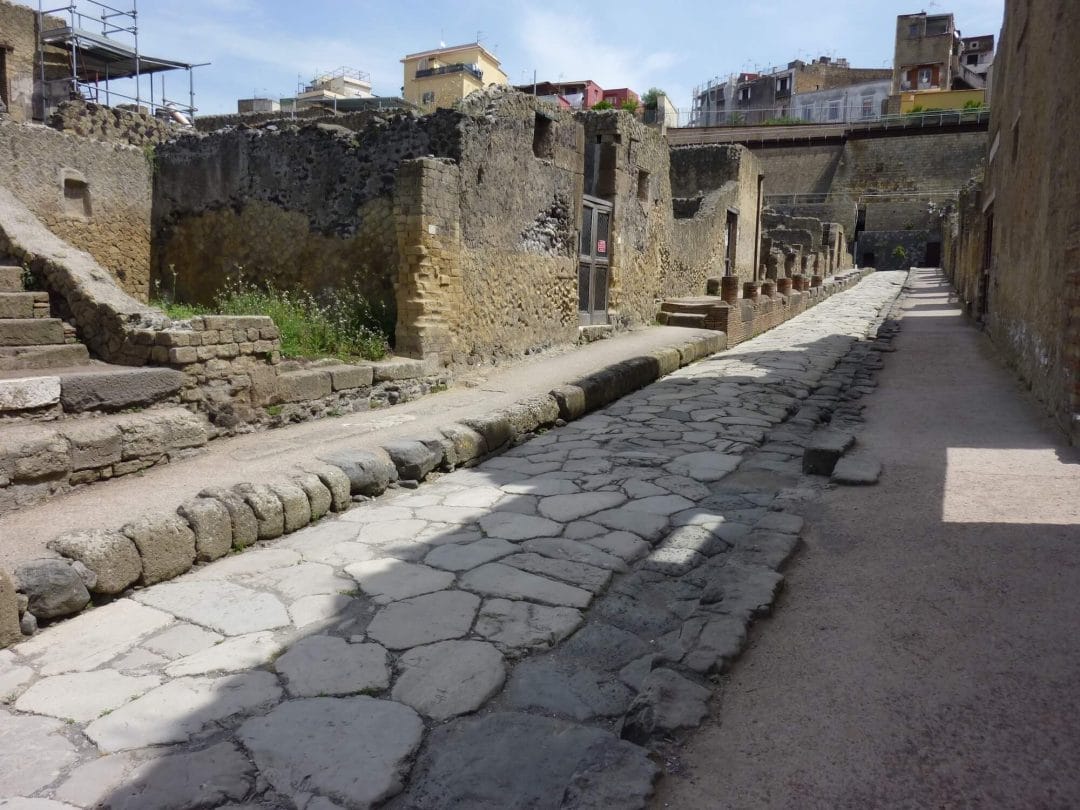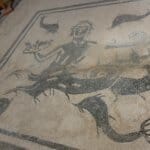Smaller than its infinitely more famous southern neighbour Pompeii, the port town of Herculaneum (along with Stabiae, Oplontis and Boscoreale) was also wiped off this planet when Vesuvius erupted in 79AD. Sitting on the north western flank of Vesuvius, the remaining townspeople of Herculaneum had no chance of survival once the volcanic column collapsed and formed a massive pyroclastic surge of superheated gas, ash and earth that rushed down the side of the mountain at 160kph and engulf the town in minutes.
The first excavations were in the 18th century after an accidental discovery by a farmer digging a well but came across an immaculately preserved villa. The excavations stopped however with the discovery of Pompeii 10 years later in 1748. Buried in 4 meters of ash instead of the 20+ in Herculaneum, Pompeii was far more easily accessible.
Most of what we associate as Herculaneum today was excavated between 1927-1942 although a chaotic section in the northwest was excavated between 1996-1999 and deliberately left in this state so we can observe the sometimes destructive power of the volcano.

Walking down from the Main Street of modern day Ercolano, visitors are treated to a panoramic view of the ruins of Herculaneum 20 meters below street level.
The Boathouses on the ancient shore are the final resting places to the majority of casualties in the town. Preserved, buried in a meters high wall of solidified ash and mud, the full story of Herculaneum would not come to light until the fate of the people of Pompeii would captivate the world.
The prevailing wind on the night of the eruption, largely spared Herculaneum who only a few centimetres of ash falling while the buildings of Pompeii would collapse under the weight of the ash raining down on them for nearly 48 hours until the volcanic column that had been rising into the troposphere finally collapsed under its own weight and engulfed the towns dotted on its steep sides and all who remained in them.
Most of Herculaneum, roughly 70%, still lies buried under the 20 meters of ash, still perfectly preserved. All funding now goes towards preserving the town from destruction by the elements and the modern day town of Ercolano (remember the name for the train stop you need to get off at) that sits atop part of Herculaneum. Water damage from the town over the years has undermined many of the buildings but preservation efforts have been more successful in recent years.
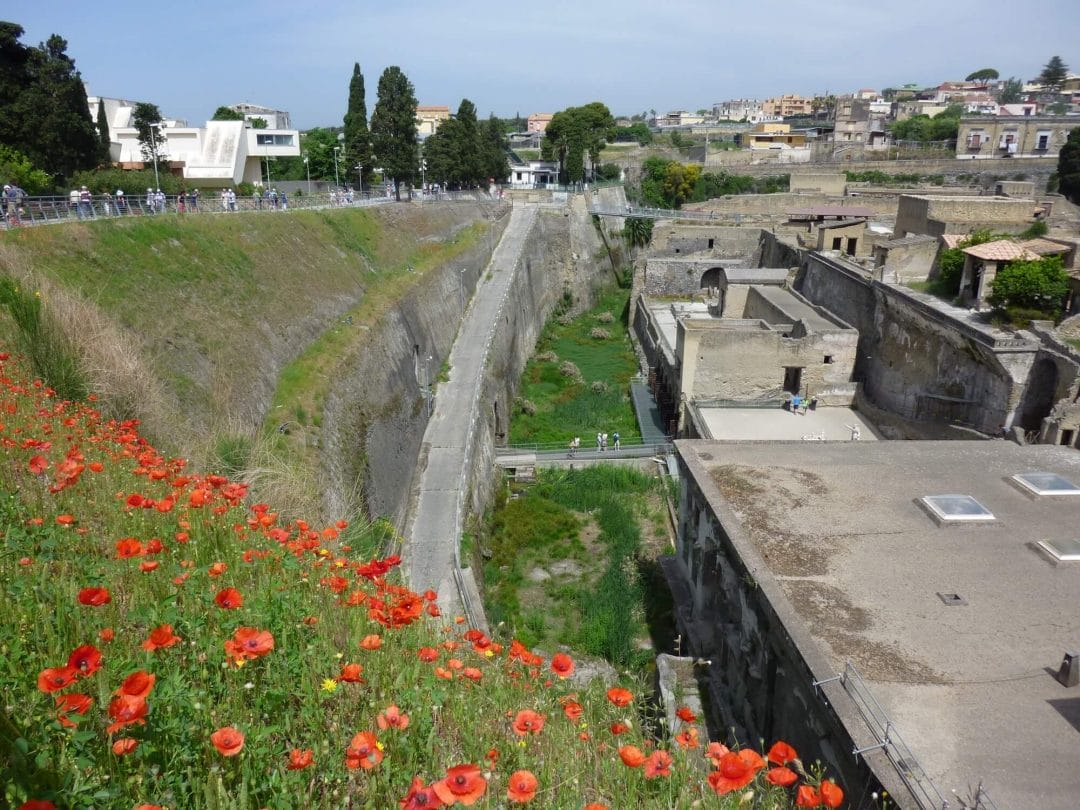
After paying your entrance fee, continue along the pathway filling the line of the ancient shore before descending through the solidified ash.
There are a lot of people asking the same question ahead of their visit, “which one should I visit?”. Quite a large majority of day visitors to the Amalfi coast come only for Pompeii (especially cruise ship visitors) and, while there is much to see there (Pompeii is currently 3 times the size of Herculaneum at 163 acres), I would argue that to understand the people and the time you will have to visit both sights.
Pompeii has giant tree lined avenues, palaces, regal houses, domus’ even a giant amphitheatre and a very impressive colosseum of its own, and people. A lot of people no matter what day you visit. All those feet pounding the pavements are taking their toll on the centuries old infrastructure and for that very reason a lot of what you can see in Pompeii is behind closed bars. Offering only glimpses of what lay within, out of reach for the casual day visitor, you need to be an archeologist with special permits to gain entry to a lot of the better preserved villas in Pompeii.
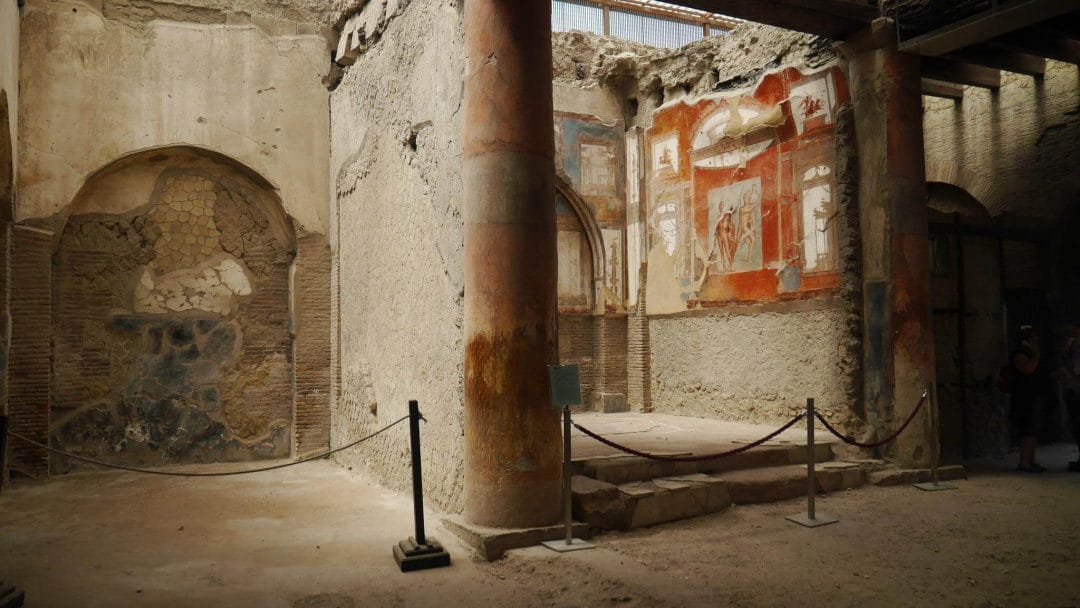
The large College of Agustales complex contains some of the best preserved wall frescos in the town. You can find it on the corner of Cardio III and Decumanus Maximus.
Even though Herculaneum is better preserved it only gets a tenth of the visitors that Pompeii does (currently just over 300,000 vs 3 million). In the shoulder season you can sit on a seat in the middle of town contemplating what these people went through and see only 1 or 2 other people. Strolling around town it’s easy to see that the people of Herculaneum were more well off than those of Pompeii. Marble is everywhere in the grand houses and frescoes on the walls are a sign of status. Street after street of impressive houses in this 4 hectare capsule into the past. The ground humidity and the way it was buried preserved more delicate objects such as the wooden frames of houses and some furniture, small bits of cloth. Carbonised bread loaves have even been discovered in a oven.
If you arrive by train and walk down the main street of Ercolano that leads you straight to the ruins of Herculaneum, you will first get a sweeping Ariel view of the ruins as you make your way down from modern day Ercolano to the Visitors centre near the ancient shoreline that acts as the visitors centre.
The commanding view down the first part of the gently sloping walkway is your free taster of the site. You only pay for entry once you arrive at the visitors centre. The pathway works its way round the town via the top of the ash flow before diving down through the multiple layers emerging at the ancient shoreline that is now over 1km inland.
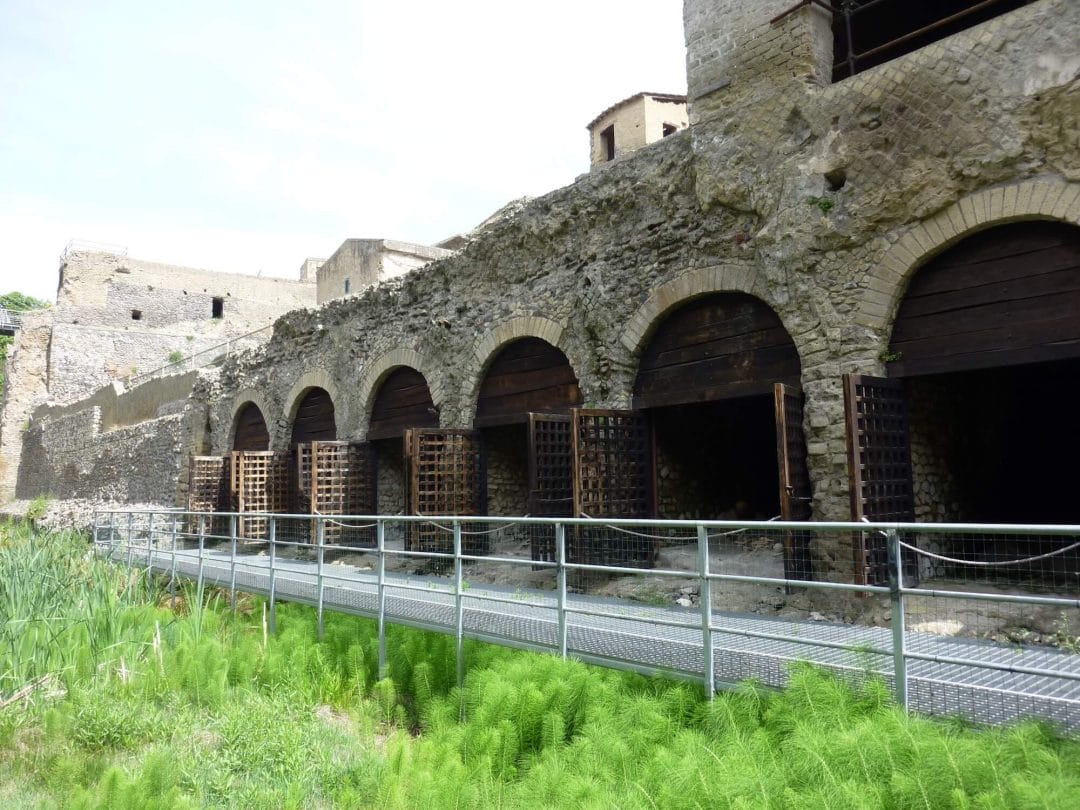
Lining the ancient shore are the boathouses where most of the victims of the 79AD eruption of Vesuvios were found in 1980.
Look to your left as you cross the walkway that leads to the town and you will see casts of skeletons clustering in a storage bay on the old promenade. Huddled together, the fear they must felt in their final moments is all to apparent. When the town was first excavated it was assumed that most of the townspeople managed to escape because no bodies were found. The 1980 excavation of the ancient shoreline however unearthed 120 skeletons which has grown to over 300 now.
The remaining people of Herculaneum died of fulminant shock while waiting for rescue by water. Initially it was assumed that they suffocated with the huge amounts of ash but studies of their postures and skeletal remains show that it was the superheated atmosphere caused by the pyroclastic flow that caused their demise long before they could have suffocated.
Its a sobering start to the town, having to first descend through a tunnel carved through the ash to get to this point. Looking at the walls in the tunnel as you descend down it is hard to comprehend that this was all from one eruption but Vesuvius is a beast of a volcano that sometimes comes to life with terrifying force.
Climbing up from the shoreline to a plaza with arguably one of the best views in the ancient town, the streets open up from a plaza near the old shore. You are free to explore on your own or you can take an audio tour for a small fee.
The Villa Of Papyri is probably the most famous of the buildings and original home of the famous Herculaneum Scrolls which are now in the Naples Museum. New infra red scanning techniques mean the information the carbonised rolls of paper have hidden for so long may finally be deciphered. Sadly the Villa was closed on my visit and currently remains closed to visitors but check before you visit just in case it opens its doors to visitors again.
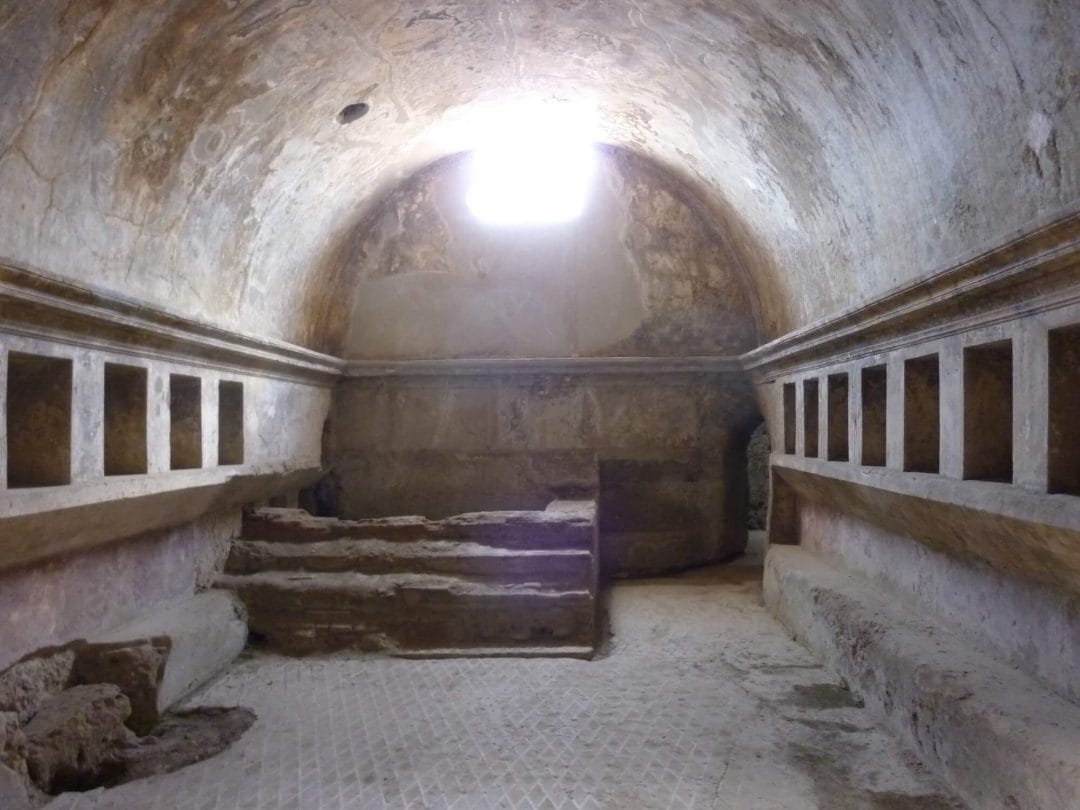
Natural lighting floods the rooms of the Central Thermae while intricate under floor plumbing ensured the rooms were kept at the right temperature.
The Central Thermae is another remarkable site. Thermal baths were very popular at the start of the last century, especially popular in Herculaneum and Pompeii. As was traditional for the time, there are separate baths for each sex. While the rooms now lack the grandeur of their heyday it’s easy to place yourself in that time while standing in the middle of the bath instead of just reading about it. There are several well preserved frescoes around the small maze of interconnected rooms. Take the time to explore the darkened rooms at your leisure and take in the marvel at this intricate building.
As good as a lot of the buildings are, it is the atmosphere that you can feel while just wandering the streets and exploring. By all means, take the audio tour to understand more of what you are seeing but before you leave just wander, sit and take in the unique atmosphere that you can only get in Herculaneum precisely because it is quieter than Pompeii.
Pompeii or Herculaneum? I would argue that you really should make time for both. Will the rest of Herculaneum be released from its ash laden grave? That may be a little difficult on account that 2 modern towns now sit over the site but with so much of it still cocooned in its perfectly preserved state, and advances in modern archeology are lightyears ahead since both Pompeii and this small section of Herculaneum were liberated from their separate tombs.
Eventually the secrets that Herculaneum protects will be revealed but for now just enjoy the peace and serenity that is here and was cruelly denied tot hat of its last inhabitants. Pompeii may be the main draw but Herculaneum is the real treasure.
 Copyright secured by Digiprove © 2017
Copyright secured by Digiprove © 2017

